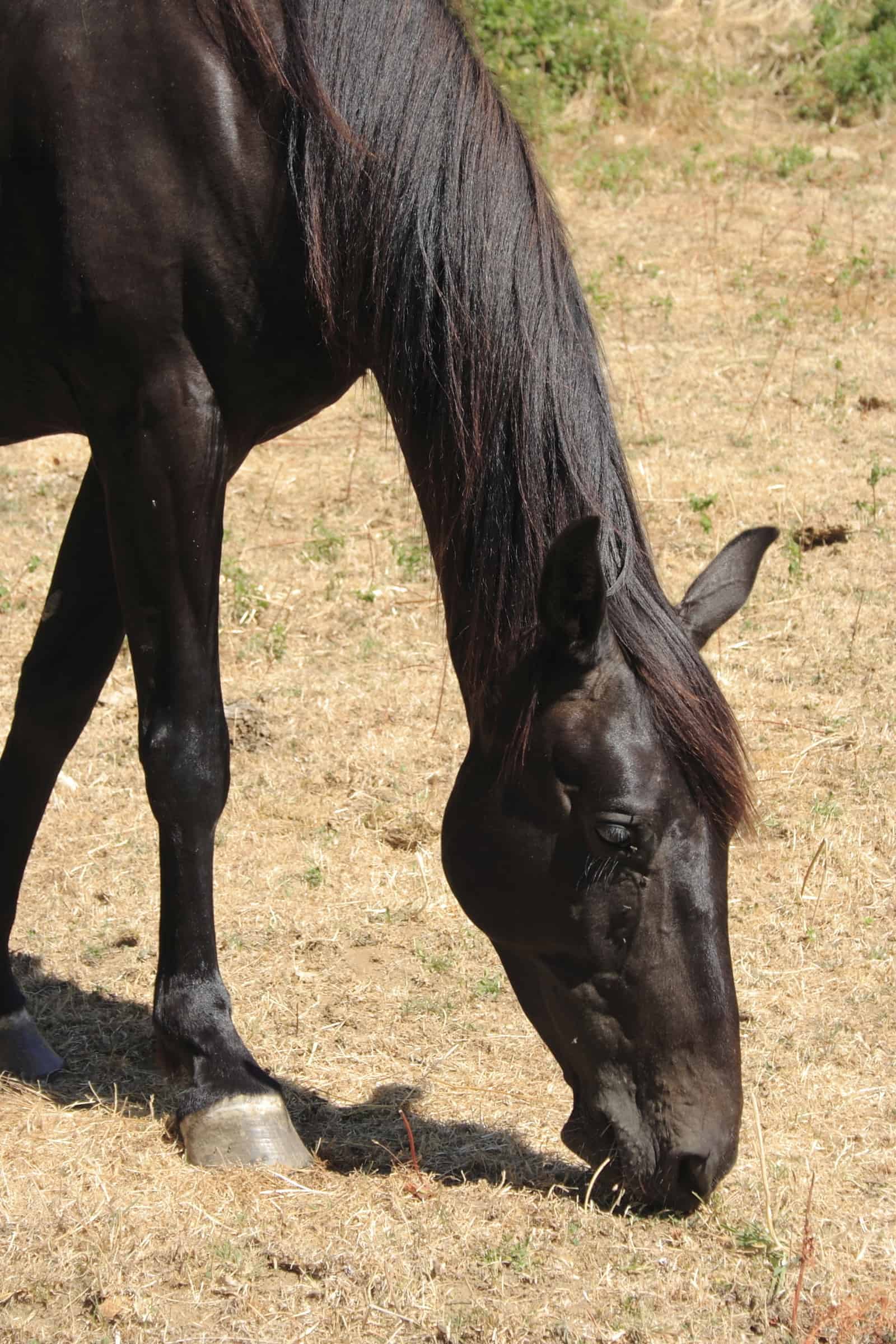Managing Horses During Drought

Several areas of the country, such as California, are currently experiencing drought. Abnormally dry conditions pose unique health care and management challenges for horse owners.
Pasture
Horses on productive pastures tend to exercise naturally as they graze; this constant moving and foraging is beneficial for their digestive health. When green pasture dwindles, however, horses tend to exercise less and instead wait in the shade for feeding time. These horses are more inclined to have gastrointestinal problems that can lead to colic. Thus, under these conditions I recommend feeding horses a generous amount of a bland (such as long-stem) grass hay to keep them eating and occupied during the day. This is preferable to having them wait around for an occasional rich feeding. When moisture finally returns, it is important to moderate horses’ access to rapidly changing pasture, so their systems can readjust to green grass.
Hay
Drought conditions also reduce hay supplies, making it difficult for owners to maintain consistent hay diets for their horses. Radically changing feed types increase a horse’s risk for health problems, especially colic. If you can’t maintain a consistent hay type, source, and quality, gradually reduce the amount of the old batch you feed, mixing it with an increasing amount of the new hay (over three to five days) to ease the transition. When purchasing hay from a new source, always examine it carefully for mold, dust, weeds, blister beetles, and sharp seed awns. While feed concentrates can supplement horses’ diets in some cases, they should not replace hay (high fiber or roughage feeds). Hay should be the staple of the equine diet.
Toxic Plants
Horses with adequate forage usually avoid eating toxic weeds. During drought conditions, however, when weeds might be the only green plants on pasture, horses are more likely to eat them. The best way to prevent this is to provide more consistent access to good-quality hay. Talk to your vet or local equine extension agent about the toxic plants in your area. You should learn to recognize these and, if possible, remove them from pastures.
Sand Colic
Horses tend to ingest more dirt and sand when pastured in drought conditions as they try to graze the last few short shoots and roots. Sand accumulation in the gut is a serious problem that can lead to colic and diarrhea. Reduce sand ingestion by feeding off the ground or feeding in sand-free areas of the pasture. This sometimes requires more than simply using a feeder, as hay usually still falls on the ground and is picked out of the soil. Consider placing rubber mats under feeders or feeding in stalls without sandy floors. Feeding a psyllium product regularly (usually one week per month) can also be beneficial, but it should complement these other management practices–don’t rely on it alone. Also, rotate pastures to avoid overgrazing and to help keep drought-stressed grasses alive. This will preserve some ground cover, thus reducing wind and water erosion and soil loss later.
Water
A pond or stream that pastured horses use as a water source might dwindle or become stagnant in drought conditions. Monitor water quality in these situations and provide extra fresh water. If horses are housed in large groups, offer plenty of room for watering and feeding because injuries can occur as horses compete for limited watering and feeding areas.

Wind
Also take into account wind; blowing dust can irritate eyes and cause respiratory problems. Fly masks provide protection from insects and some can also help protect from intense sunlight and dust. Adequate shelter and clean bedding can also help horses avoid airborne dust.
Disease
Certain diseases such as pigeon fever (dryland distemper), vesicular stomatitis, and Rhodococcus equi pneumonia in foals can be more common in dry, hot, and dusty conditions. Know these diseases’ clinical signs so you can contact your vet immediately if you see signs develop.
Wildfire
Drought also has led to wildfire risks in many areas, especially heavily wooded regions. Horse owners who live in fire-prone areas should prepare for wildfires by having evacuation plans. All horse owners should have (or have easy access to) a serviceable truck and trailer they can use quickly in an emergency.
Work with your veterinarian and be aware of drought-related problems to help maintain your horse’s health and welfare during this potentially stressful time.
Written by:
Doug Thal, DVM, Dipl. ABVP
Related Articles
Stay on top of the most recent Horse Health news with















